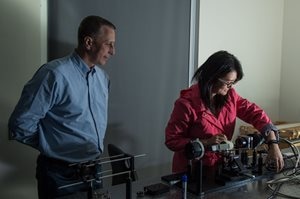May 21 2019
A novel compact, fiber-based imaging spectrometer has been recently developed by researchers for remote-sensing applications. This instrument is capable of capturing 30,000 sampling points, with each containing over 60 wavelengths.
 Tomasz S. Tkaczyk and Ye Wang were part of the team that developed a new compact imaging spectrometer for remote sensing applications. The instrument can capture more than 30,000 sampling points each containing over 60 wavelengths. (Image credit: Rice University
Tomasz S. Tkaczyk and Ye Wang were part of the team that developed a new compact imaging spectrometer for remote sensing applications. The instrument can capture more than 30,000 sampling points each containing over 60 wavelengths. (Image credit: Rice University
Combined with high spatial resolution, this rich spectral data offer useful insight into the chemical composition of a sample or scene.
Compact imaging spectrometers such as the one we developed can be used on unmanned aerial vehicles to help increase crop production or inform response after a disaster based on detected pollution. In the biomedical field, the system could increase the efficiency of diagnostic tests or help scientists better understand biological processes.
Tomasz S. Tkaczyk, Research Team Leader, Department of Bioengineering, Rice University
The researchers have described in The Optical Society (OSA) journal, Optics Express that their innovative device has the potential to offer about an order of magnitude more data when compared to other fiber-based instruments that have been previously reported. The instrument measures just 600 x 150 x 150 mm, which makes it nearly small enough for use in unmanned aerial vehicles. In addition, the device can possibly be made even smaller and, at the same time, it can capture over 100 wavelengths from up to 250,000 points, say the research team.
The innovative spectrometer instantaneously obtains spectral data without needing any scanning. This enables it to rapidly image changing objects, for example, changing imaging conditions or moving targets.
Creating a smaller fiber bundle
A fiber bundle can be used by imaging spectrometers to convey the spectral image to a detector array or a detector. Spectrometers that integrate this setup generally contain a bundle of fibers that are organized in a single line at the detector end and in a square at the input end. This implies that the number of fibers, and thus the spatial resolution, is restricted by the detector’s dimensions.
To increase the spatial sampling for our new fiber bundle design, we placed the fibers into multiple rows with gaps between each row. An added benefit of this design is that the size of the gaps can be changed to tune the balance between spatial and spectral sampling to meet specific application requirements.
Tomasz S. Tkaczyk, Research Team Leader, Department of Bioengineering, Rice University
Small-diameter fibers, which are commercially available in the market and appropriate for imaging spectroscopy, usually have a diameter of 125 to 250 µm that rapidly increases the dimension of the fiber bundle. Hence, to keep things as compact as possible, the scientists utilized a multi-core fiber ribbon that is commercially available in the market and in which every fiber has a core of 10 µm. The researchers also improved the numerical apertures of the fibers to maximize the light gathering ability.
An extensive calibration process may be required for collecting spectra from over 30,000 fibers. Hence, to resolve, this, the team created a rapid technique that takes not more than 5 minutes to calibrate all the system’s spatial samplings and requires acquiring just a few images.
Capturing spectral images
To demonstrate the novel spectrometer, the researchers used it to image remote vegetation and scenes on the campus of Rice University.
These tests demonstrated the system’s spectral imaging capability and showed its significant promise for use in environmental and remote sensing applications. Our new rapid calibration method for imaging spectrometers with high spatial sampling could also be extended to calibrate fiber bundles and other imaging devices.
Tomasz S. Tkaczyk, Research Team Leader, Department of Bioengineering, Rice University
At present, the scientists are working to further enhance the device. Their aim is to make the fiber bundle much more compact by utilizing custom fiber ribbons, and they are also exploring ways to maximize the light throughput of the systems.
The study is a part of an environmental imaging program funded by NASA’s Earth Science Technology Office aimed at developing tunable and compact imaging spectrometers that can be applied to a wide range of platforms and applications, for example, satellites and unmanned vehicles.